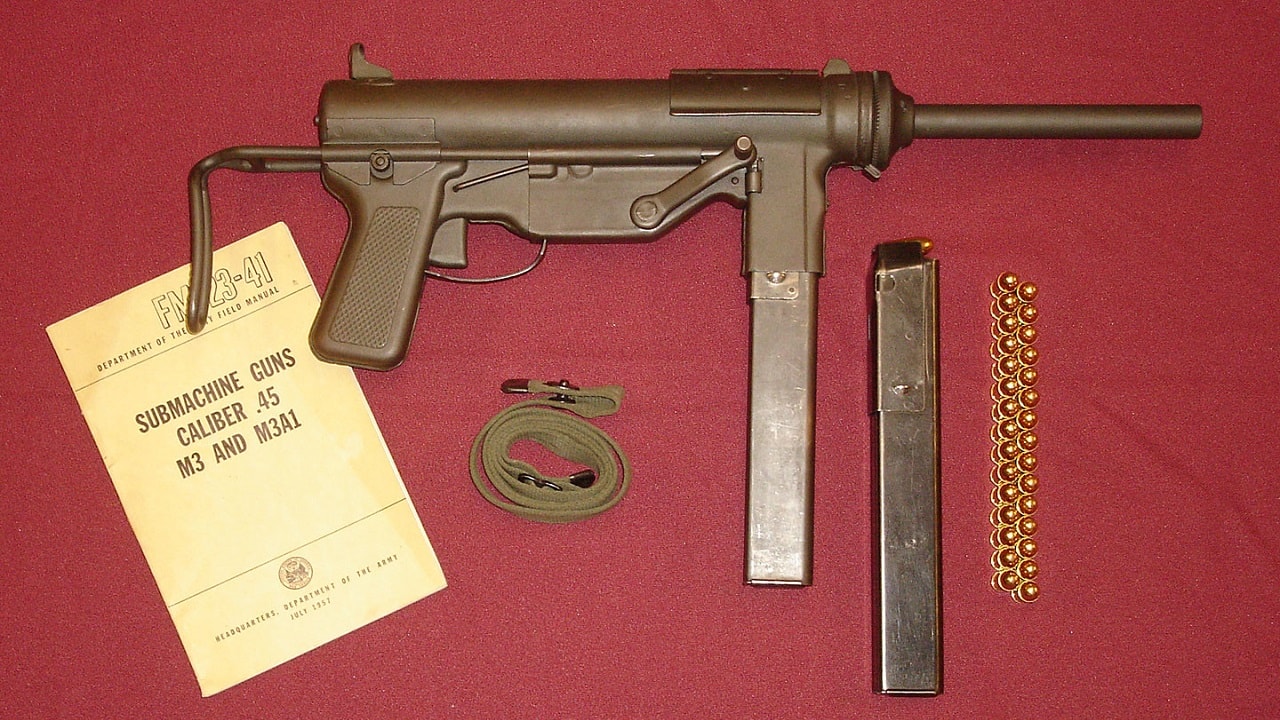Officially designated as United States Submachine Gun, Cal. 45, M3, the venerable M3 was officially introduced into service in 1944. As noted by Clare Fitzgerald in a guest column for War History Online:
“In 1941…the US Army Ordnance Board initiated a study to help develop a replacement for the World War I-era Thompson. Known as the ‘Tommy Gun’ among soldiers, the Thompson was heavy and expensive to produce, due to the amount of steel needed to manufacture it, and officials were looking for a low-cost option.
“Five pre-production models of what would later become the M3 ‘Grease Gun’ were sent to Aberdeen Proving Ground in November 1942 for service trials. By January the following year, the weapon was given the official stamp of approval, allowing production to begin at GM’s Guide Lamp Division.
“Throughout the course of the Second World War, 606,594 M3s were manufactured, with 48,669 of its variant, the M3A1, coming off the production line.”
The M3 economized on production time and costs by basically taking two pieces of stamped steel and welding them together. By contrast, Tommy Guns used high-grade steel and wood.
Another cost-saving measure was the elimination of the semi-automatic fire mode — full-auto fire was the only option. However, in order to aid with controllability, the gun was built with the relatively modest cyclic rate of 450 rounds per minute, which equates to 7.5 rounds per second. Contrast this with, say, the 600 rpm rate of fire on the Uzi SMG or the mind-numbing 1,200 rpm on the MAC-10 SMG.
The Grease Gun did retain two features in common with the Thompson SMG: open-bolt operation and the .45 ACP cartridge, the latter feature allowing for commonality of caliber with the M1911-A1 service pistol.
Dimensions of the SMG included an empty weight of 8.15 pounds (7.95 lbs for the M3A1 variant), an overall length of 29.1 inches with the stock extended or 21.9 inches with the stock collapsed, and a barrel length of 8 inches. That 8-inch barrel generated a muzzle velocity of 900 feet per second and a maximum effective range of 100 yards.
American GIs, particularly paratroopers, Rangers, tankers, and armored infantrymen, came to appreciate the weapon’s portability, stopping power, and reliability.
Still Going Strong During Desert Storm
Building on its initial battlefield success in World War II, the M3A1 continued on as the standard U.S. SMG during the Korean War. And although SMGs were far less common with the U.S. Armed Forces by the time of America’s participation in the Vietnam War, the gun was still very much in use with U.S. Army Special Forces, Marine Recon, and America’s allies in the Army of the Republic of Vietnam. It was even the initial SMG of choice of the Army’s elite Delta Force upon that unit’s inception in 1977. During Operation Desert Storm in 1991 — 50 years after the weapon’s initial conceptualization — the Grease Gun was still wielded by American tank crewmen for short-range defensive use.
M3 Movie Stardom
Not surprisingly, thanks to its real-world service, this SMG made its fair share of appearances in WWII movies and TV series, among them The Dirty Dozen, Battle of the Bulge, and HBO’s Band of Brothers.
The Grease Gun even made a cameo of sorts in the most popular sci-fi franchise of all-time. As noted by Peter Suciu, the C96 “Broomhandle” Mauser semi-auto pistol “was dressed up in Star Wars and with the addition of a muzzle cone from an M3 ‘Grease Gun’ and Hensoldt Wetzlar Dialyt 3x scope it became the BlasTech DL-44. It was carried by intergalactic rogue Han Solo (Harrison Ford) and Jedi-in-training Luke Skywalker (Mark Hamill).”
Not even Dirty Harry’s Smith & Wesson Model 29 .44 Magnum or James Bond’s Walther PPK .32 ACP can top that particular cinematic claim to fame!
Want Your Own?
If you’re willing and able to deal with the bureaucratic headaches and the expense of obtaining a Federal Firearms License (FFL) and ATF Form 4 necessary to legally obtain fully automatic weapons in the U.S, then be ready to break out your bankbook: Midwest Tactical Inc. is selling genuine WWII-vintage M3s ranging from $20,000 to $38,000. If, on the other hand, you’re willing to settle for replicas/recreations, Valkyrie Arms, Ltd. lists a carbine version for $1,350 / $1,550 (wholesale / MSRP).
Christian D. Orr has 33 years of shooting experience, starting at the tender age of 14. His marksmanship accomplishments include: the Air Force Small Arms Ribbon w/one device (for M16A2 rifle and M9 pistol); Pistol Expert Ratings from U.S. Customs & Border Protection (CBP), Immigration & Customs Enforcement (ICE), and the Federal Law Enforcement Training Center (FLETC) Criminal Investigator Training Program (CITP); multiple medals and trophies via the Glock Sport Shooting Foundation (GSSF) and the Nevada Police & Fires Games (NPAF). Chris has been an NRA Certified Basic Pistol Instructor since 2011. In his spare time, he enjoys (besides shooting, obviously) dining out, cigars, Irish and British pubs, travel, USC Trojans college football, and Washington DC professional sports. If you’d like to pick his brain in-person about his writings, chances are you’ll be able to find him at the Green Turtle Pasadena in Maryland on Friday nights, singing his favorite karaoke tunes.
From 19FortyFive
The 5 Best .22 LR Semiautomatic Pistols On Earth
Ukraine Footage Shows U.S. M982 ‘Excalibur’ Cut Through Russian Artillery
How To Sink A $3 Billion Dollar Submarine: Leave A Hatch Open

